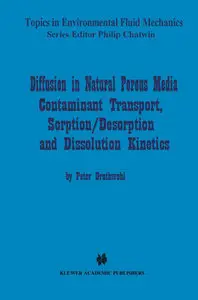"Diffusion in Natural Porous Media: Contaminant Transport, Sorption/Desorption and Dissolution Kinetics" by Peter Grathwohl
Topics in Environmental Fluid Mechanics, Volume 1
KluAcad Publishers / SpriSci+Business Media | 1998 | ISBN: 0792381025 9780792381020 9781461376026 9781461556831 | 216 pages | PDF | 8 MB
Topics in Environmental Fluid Mechanics, Volume 1
KluAcad Publishers / SpriSci+Business Media | 1998 | ISBN: 0792381025 9780792381020 9781461376026 9781461556831 | 216 pages | PDF | 8 MB
This book introduces the general principles of diffusion in the subsurface environment and discusses the implications for the fate and transport of contaminants in soils and groundwater. Emphasis is placed on sorption/desorption and the dissolution kinetics of organic contaminants, both of which are limited by the slow speed of molecular diffusion.
The book examines sorption/desorption rates of organic compounds in various soils and aquifer materials, and also examines the dissolution kinetics of nonaqueous phase liquids in aquifers, in both the trapped residual phase and in pools.
The author uses analytical solutions of Fick's 2nd law and some simple numerical models to model diffusive transport under various initial and boundary conditions. A number of these models may be solved using spreadsheets.
Contents
Foreword
Notation
1: Introduction.1.1. Persistence of Organic Contaminants in the Subsurface Environment. 1.2. Nonequilibrium Transport - Remediation of Contaminated Sites. 1.3. Diffusion in Sediments and Rocks.
2: Basics of Sorption and Diffusion in Soils and Sediments. 2.1. Sorption of Organic Compounds in Soils and Sediments. 2.2. Mass Transfer by Diffusion.
3: Modeling of Diffusion Processes. 3.1. Intraparticle Diffusion. 3.2. Diffusion into Layers of Low Permeability.
4: Measured Diffusion Coefficients. 4.1. Time-Lag Experiments. 4.2. Diffusion Coefficients from Sorption/Desorption Kinetics. 4.3. Prediction of Diffusion Coefficients.
5: Dissolution Kinetics of Non Aqueous Phase Liquids. 5.1. Aqueous Solubility of Organic Compounds. 5.2. Dissolution Kinetics.
6: Risk Assessment - Remediation. 6.1. Risk Assessment: Release Rates. 6.2. Time Scales of Soil and Groundwater Remediation. 6.3. Transport by Diffusion Compared to Advection. References.
Appendices:
I. Analytical Methods: TCE and Phenanthrene.
II. Methods of Solids Characterization.
III. TCE-Diffusion Data: Time-Lag Method.
IV. Sedimentary Rocks Used in Tracer (Iodide) Diffusion Experiments (Soving, 1992; Mauch 1994)
V. Long-Term Sorption Kinetics of Phenanthrene in Lithofragments and Aquifer Lithocomponents from the Horkheim Site
Index
1st with TOC BookMarkLinks



